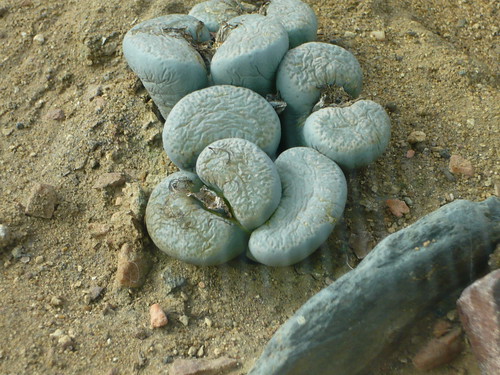Living Stones – Growing Lithope
As a child I tried with seeds to grow stones – daft kid or what? Now I do not see the fun in growing Lithopes, due to the early aversion thereapy, but each to their own.
Lithopes are succulents often collected by Cactus growers. Plants consist of one or more pairs of bulbous leaves and hardly any stem. The slit between the leaves  produces white or yellow flowers and new leaves. During winter a new leaf pair grows inside the existing fused leaf pair. The old leaf pair parts to reveal the new leaves and the old leaves will then dry up
I can’t beat the full description, history notes and cultivation report on the BBC web pages. In case the page gets taken down in a cost cutting exercise I have repeated some of the key content.
‘Growing Lithops at Home
- Not the easiest of plants to grow, Lithops can however be persuaded to flourish with a few simple rules and a degree of care. A greenhouse, while not absolutely necessary, is an advantage.
- Lithops prefer free-draining soil. Ready-made cactus soil can be bought at most nurseries and garden centres, and Lithops will grow well in it, but they will fare even better if you add one part of sharp sand to two parts of cactus soil.
- The most important rule is not to overwater these plants. In the wild they often survive for months on end without water, and they can do the same in captivity. Lithops cannot stand moist soil and will soon rot if their roots remain wet for more than a few days.
- In the northern hemisphere, they will flower in mid to late autumn. As soon as flowering ceases, so should all watering. No more water will be needed until the old leaves have almost completely dried up, although it is beneficial to mist them once a week with a fine spray of water.
- In the wild, Lithops are almost entirely embedded in the soil, only showing their top surface. In cultivation they usually stand proud of the soil because the collector is giving them more than ideal growing conditions and a more regular water supply than they will usually get in their natural habitat.
- Too much sunlight can burn a Lithops – or rather, cook it from the inside out, as the water held in its tissues heats up. They will benefit from some direct sunlight, but not all day long, especially in a greenhouse.
- Daytime temperature  between 75° and 95°F during the summer, and not allowed to fall below 50°F during the winter. They can be kept at cooler temperatures but will not withstand a frost, prefer a dry, arid atmosphere, and will not do as well in high humidity.
- In the wild, Lithops exist on the margins of survival and have evolved to grow where nutrients are few and far between. Feeding them in cultivation is not necessary – too much in the way of fertiliser can make them grow too quickly and become unnaturally large.
More information from Lithops info.
Read ‘Lithops- Flowering Stones’ by Desmond and Naureen Colefrom Amazon
